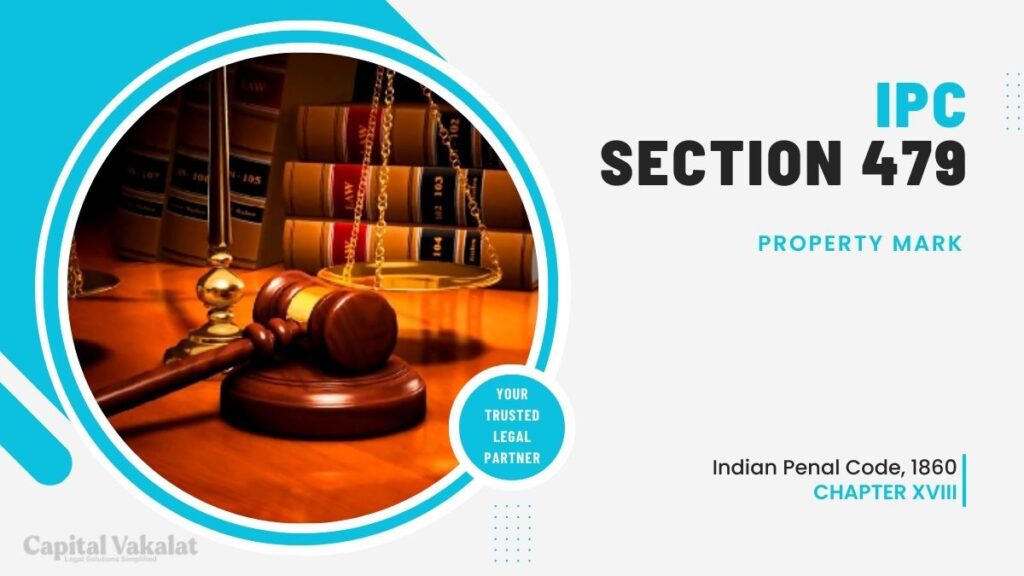In the vast expanse of legal frameworks, Section 479 IPC stands out as a crucial element, especially when it comes to the protection of property marks. These marks, often synonymous with trademarks, play a pivotal role in safeguarding intellectual property and maintaining fair competition in the market.

In this article, we delve into the intricacies of Section 479 IPC, exploring its nuances, historical context, and the impact it has on businesses and consumers.
Understanding Section 479 IPC
Section 479 IPC, or Indian Penal Code, addresses the issue of property marks, defining the legal parameters surrounding their protection. It encompasses a wide array of marks, including trademarks, service marks, and collective marks, aiming to create a robust mechanism for safeguarding the distinctive identity of products and services.
Historical Context
To comprehend the significance of Section 479 IPC, it’s crucial to delve into its historical roots. The concept of property marks has evolved over time, with landmark legal cases shaping its trajectory. These cases have played a pivotal role in defining the boundaries and applications of Section 479 IPC, creating a legal foundation that continues to influence contemporary judgments.
Significance of Property Marks
Property marks are not merely symbols; they are a cornerstone in the protection of intellectual property. In a global marketplace rife with competition, these marks serve as a shield against counterfeit products, ensuring that consumers receive genuine goods and services.
Elements of a Valid Property Mark
For a property mark to be recognized under Section 479 IPC, it must meet certain criteria. These criteria often include distinctiveness, non-generic nature, and uniqueness. Through examples of recognized property marks, we gain insights into what qualifies as a valid mark and what falls outside the legal purview.
Legal Procedures and Remedies
Section 479 IPC provides a legal recourse for individuals and businesses whose property marks face infringement. Filing complaints under this section involves a series of procedures, and understanding the legal actions available is crucial for those seeking redress. From cease-and-desist orders to civil litigation, the legal arsenal is diverse.
Challenges in Enforcing Section 479 IPC
In an era of globalization and digital connectivity, enforcing Section 479 IPC comes with its set of challenges. Cross-border issues, the rapid spread of information, and the emergence of new technologies present obstacles that demand continuous legal adaptation.
Impact on Businesses and Consumers
The impact of Section 479 IPC extends beyond legalities, profoundly influencing businesses and consumers alike. For businesses, adhering to these regulations is not just a legal requirement but a strategic necessity. Consumer trust and safety are at stake, making adherence to property mark laws paramount.
International Comparisons
To gain a comprehensive understanding, it’s insightful to contrast property mark laws globally. Different jurisdictions approach the protection of property marks in unique ways. Examining international best practices can offer valuable insights, potentially influencing the evolution of Section 479 IPC.
Future Trends and Developments
As the legal landscape evolves, so does Section 479 IPC. Anticipating future trends and potential developments is crucial for stakeholders navigating the intricate world of property marks. Whether influenced by technological advancements or changing consumer behaviors, staying ahead of the curve is key.
Conclusion
In conclusion, Section 479 IPC is a linchpin in the legal protection of property marks. Its historical roots, significance, and impact on businesses and consumers highlight the multifaceted nature of this legal provision. As the world continues to change, so too will the challenges and opportunities surrounding property marks.
Frequently Asked Questions
What legal actions can be taken against property mark infringement?
Legal actions under Section 479 IPC may include filing complaints, obtaining cease-and-desist orders, and pursuing civil litigation. The specific remedy depends on the nature and severity of the infringement.
How has globalization affected the enforcement of Section 479 IPC?
Globalization has introduced cross-border challenges in enforcing Section 479 IPC. The interconnected nature of markets requires adaptive legal strategies to address issues that transcend geographical boundaries.
What steps can businesses take to ensure compliance with Section 479 IPC?
Businesses can ensure compliance by thoroughly understanding the criteria for valid property marks, regularly monitoring for potential infringements, and promptly taking legal action when necessary.
Are there ongoing discussions or proposed changes to Section 479 IPC?
Legislative landscapes are dynamic, and discussions about potential amendments or changes to Section 479 IPC may occur. Staying informed about such developments is essential for businesses and individuals involved in the protection of property marks.